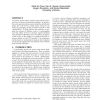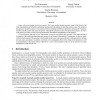207 search results - page 21 / 42 » Measuring Similarity for Security Vulnerabilities |
CCS
2008
ACM
14 years 11 months ago
2008
ACM
To protect against replay attacks, many Internet protocols rely on nonces to guarantee freshness. In practice, the server generates these nonces during the initial handshake, but ...
NDSS
2008
IEEE
15 years 4 months ago
2008
IEEE
Accurate network measurement through trace collection is critical for advancing network design and for maintaining secure, reliable networks. Unfortunately, the release of network...
CCS
2005
ACM
15 years 3 months ago
2005
ACM
Human-memorable passwords are a mainstay of computer security. To decrease vulnerability of passwords to bruteforce dictionary attacks, many organizations enforce complicated pass...
CCS
2009
ACM
15 years 4 months ago
2009
ACM
Third-party cloud computing represents the promise of outsourcing as applied to computation. Services, such as Microsoft’s Azure and Amazon’s EC2, allow users to instantiate v...
SP
2006
IEEE
15 years 3 months ago
2006
IEEE
Linux is the most popular open source project. The Linux random number generator is part of the kernel of all Linux distributions and is based on generating randomness from entrop...


